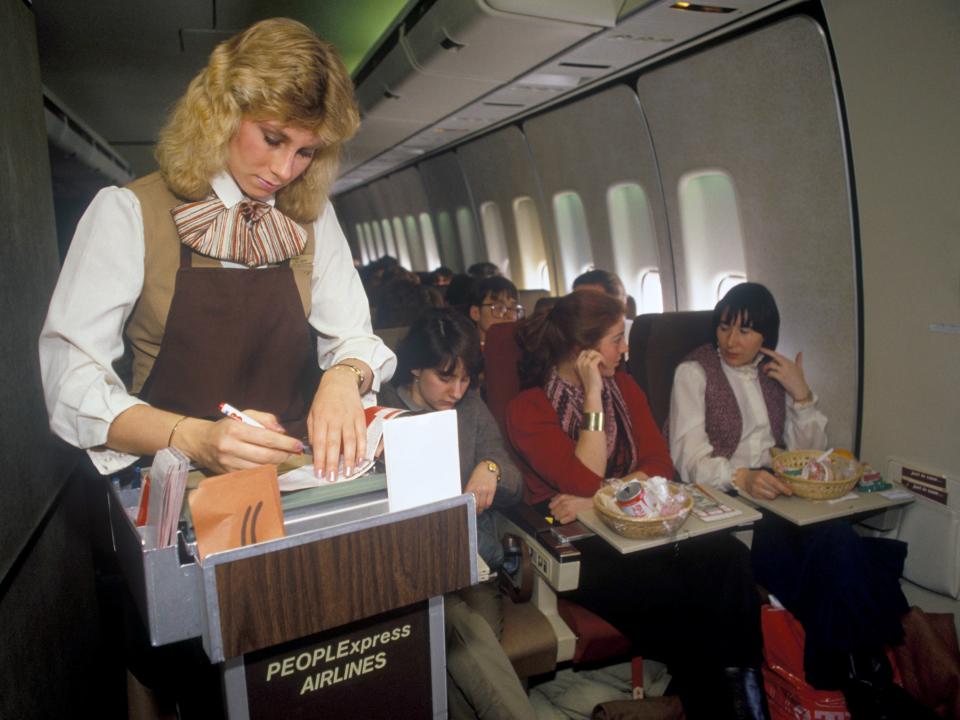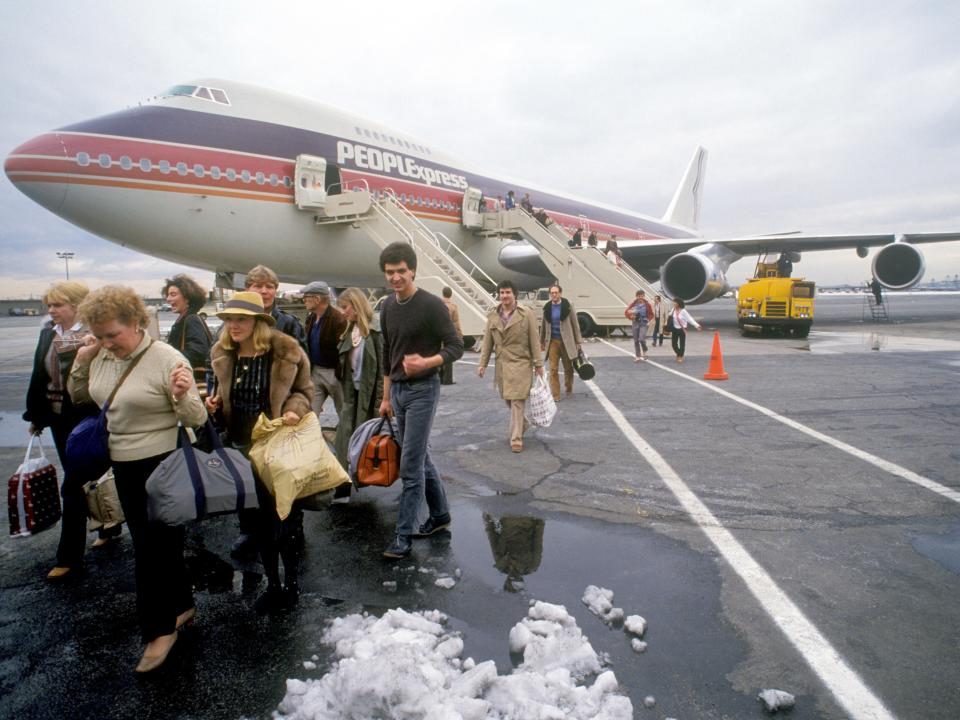10 Airlines That Actually Existed in the 1980s
By Barbara Peterson. Photos by: Alamy.
Back in the go-go 1980s, the airline business was like catnip to any self-respecting (or self-aggrandizing) entrepreneur. Newly deregulated, the airlines appeared to offer an aspiring tycoon a fast path to prestige and riches—or so it seemed. With the active encouragement of Washington policymakers (not to mention Wall Street bankers eager to cash in on these schemes), more than 100 airlines announced their intention to apply for scheduled airline authority in the decade after President Jimmy Carter signed airline deregulation into law in 1978.
Some of these companies succeeded wildly before the proverbial crash to earth; others were so far-fetched they never even took off. Here, some of the more memorable airlines that tried.
MGM Grand Air
Billionaire Kirk Kerkorian, who made his fortune developing Las Vegas casinos, figured he could roll the dice with an idea whose time seemed to have arrived: the all-first-class airline. He grabbed some narrowbody jets, ripped out the old coach seats, and tarted them up with leather swivel chairs, queen-size beds, tuxedoed flight attendants, and a stand-up bar. (Some of the fleet came from an earlier, short-lived, attempt at the concept, Regent Air.) Luxury scheduled flights between Los Angeles and New York JFK debuted in mid-1987, but despite the celebrities it attracted (Madonna; Axl Rose) and the fact that it charged $2,000 for round-trip fares, it never made money. The airline fizzled out in the mid-90s.
Trump Shuttle
In the late 1980s, a New York real estate heir named Donald Trump was on a roll, snapping up trophy properties like Manhattan’s Plaza hotel. So when a chance to join the exclusive airline club came his way, he jumped—apparently without looking too hard at the merchandise. What he got was a geriatric fleet of 727s operated by the Eastern Shuttle from New York City to Washington, D.C. and Boston, which parent Eastern Airlines had put on the block. Trump slapped his name on the planes and spent millions glitzing up the interiors with chrome and faux marble touches, but it never turned a profit, and the now-president was forced to divest the airline in 1990.
People Express
Before Virgin or JetBlue, there was the cult of People Express, which became a media darling after taking off in the early 1980s under the leadership of its charismatic and visionary founder, Don Burr. The Harvard-educated businessman was an airline veteran, but his ideas for his own airline shocked the then-staid industry; his employees rotated among jobs—pilots would load bags and financial analysts would moonlight as flight attendants—and customers paid for their tickets onboard the plane. With fares starting at $23 one-way in the Northeast, the no-frills airline launched with virtually no advertising and was an instant hit. Then Burr got too ambitious: he snapped up some used 747s, added a first class, and began flying to London and other European capitals; soon, the formerly profitable line was quickly awash in red ink. People Express was acquired by Continental Airlines in 1987.
The Hawaii Express
More than 30 years before packed planes became the new normal, a businessman named Michael Hartley hit on what seemed a surefire success: jamming a 747 plane with 501 seats (versus around 400 in a conventional, multi-class layout.) He offered tickets from Los Angeles to Honolulu at the absurd-sounding price of $89.95, nicknaming it “The Big Pineapple.” Established airlines on the route were quick to teach the interloper a lesson, slashing their own fares to Hawaii Express's prices (only to raise them when the airline, predictably, lost customers and shut down.)
Challenge International Airlines
Maybe names do really matter, and calling an airline company a “challenge” hardly inspires confidence. But an overabundance of confidence may have led some aviation executives in the mid-1980s to create a passenger sibling to their all-cargo airline, using a fleet of 727s and 737s to fly from East Coast cities like Newark to Miami to points all over the Caribbean and Central America. Unfortunately, it never hit on a formula for success, and its moniker became a punch line when it ran out of money in late 1987 and declared bankruptcy.
Highland Express
The brainchild of lawyer Randolph Fields, a founder of Virgin Atlantic, Highland Express was the first (and possibly only) budget transatlantic line to make Scotland its home base. It came about after Fields split with Richard Branson and cashed in his Virgin stake for a tidy profit, which he used to acquire a 747 and fly it from Prestwick, Scotland to Newark for a rock-bottom $25 one-way. Encouraged by the initial response, in 1987, he added a flight from London Gatwick, right on Virgin’s turf. But losses mounted, and Highland Express ground to a halt soon after that.
Presidential Airways
Founded by ex-People Express executives, Washington-based Presidential aimed to improve upon that dirt cheap model, with a full-service airline at discount fares. Moving into a new terminal at Dulles, the airline catered to the capital crowd with an airport VIP lounge dubbed the “Oval Office” and flights along the Eastern seaboard and other domestic points. Presidential candidate Michael Dukakis chartered one of the planes during his 1988 campaign, but both his political career and the airline were soon history, with the carrier filing for bankruptcy the following year.
Pride Air
New Orleans-based Pride Air grew out of one of the most dramatic upheavals that followed deregulation, when, in the early 1980s, industry disruptor Frank Lorenzo, who ran a small Texas airline, launched a takeover of Continental Airlines, putting that proud legacy line into Chapter 11 bankruptcy and firing thousands of workers. A group of those unemployed workers decided to get even, forming an airline that would be a model of good service and good management, with flights all over the Sunbelt. But what they got was a lesson in how hard it is for a small, under-financed carrier to compete with the big guys. It shut down after only three months in business, at the end of 1985.
The Lord’s Airline
This one could have used a little help from above. The idea, according to its initial business proposal in 1985, was to create a “warm spiritual atmosphere” aimed at born-again believers, on proposed DC-8 flights from Miami to Tel Aviv. The backers even pledged to donate a significant share of their hoped-for profits to “the Lord’s ministries.” But their dream—and their plane with its “spirit of faith” tail fin—was grounded permanently when the money ran out.
The Great American Smoker's Club
This was a spinoff of Royale West Airlines, a small mid-1980s startup that initially flew from West Coast points like Burbank to Las Vegas and Colorado. As the rest of the airline industry moved to curtail or ban smoking aboard scheduled flights, Royale entered into a plan to operate “all-smoking flights” for the Dallas-based “Great American Smoker's Club”—which, in turn, was formed to fight for “cigarette smokers’ right to smoke" and to protest what it said was the airlines’ “second class treatment” of their members. The plan was snuffed out when in-flight smoking bans started taking effect in 1988.
This story originally appeared on Conde Nast Traveler.
More from Conde Nast Traveler:
Readers' Choice Awards Reveal Best Hotels
10 Ways to Make Your Flight Hate You
The 50 Most Beautiful Places in Europe
The Most Beautiful Coastal Towns in Italy


